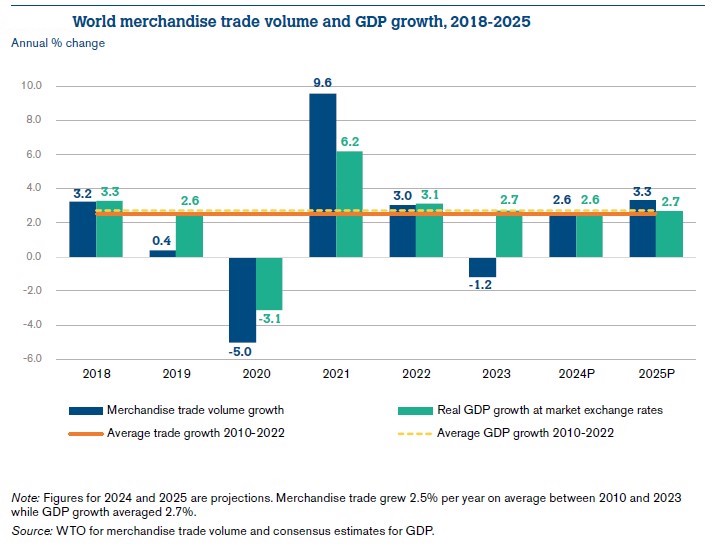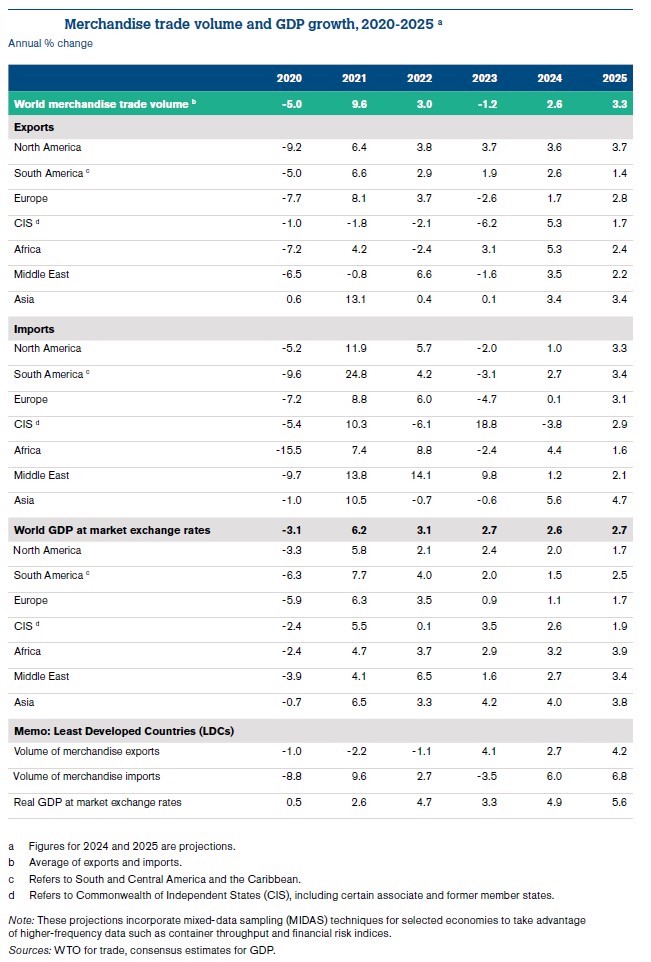
Geneva: The world merchandise trade volume is projected to pick up gradually and increase by 2.6% in 2024 and 3.3% in 2025 after falling 1.2% in 2023 due to the lingering effects of high energy prices and inflation. However, regional conflicts, geopolitical tensions and economic policy uncertainty pose substantial downside risks to the forecast, the World Trade Organization (WTO) said in a new forecast today.
The latest “Global Trade Outlook and Statistics” report released here today further predicts inflationary pressures to abate this year, allowing real incomes to grow again — particularly in advanced economies — thus providing a boost to the consumption of manufactured goods. A recovery of demand for tradable goods in 2024 is already evident, with indices of new export orders pointing to improving conditions for trade at the start of the year.
WTO Director-General Ngozi Okonjo-Iweala said: “We are making progress towards global trade recovery, thanks to resilient supply chains and a solid multilateral trading framework — which are vital for improving livelihoods and welfare. It’s imperative that we mitigate risks like geopolitical strife and trade fragmentation to maintain economic growth and stability.”
High energy prices and inflation continued to weigh heavily on demand for manufactured goods, resulting in a 1.2% decline in world merchandise trade volume for 2023. The decline was larger in value terms, with merchandise exports down 5% to US$ 24.01 trillion. Trade developments on the services side were more upbeat, with commercial services exports up 9% to US$ 7.54 trillion, partly offsetting the decline in goods trade.
Import volumes were down in most regions but especially in Europe, where they fell sharply. The main exceptions were large fuel-exporting economies, whose imports were sustained by strong export revenues as energy prices remained high by historical standards. World trade remained well above its pre-pandemic level throughout 2023. By the fourth quarter, it was nearly unchanged compared to the same period in 2022 (+0.1%) and had only risen slightly compared to the same period in 2021 (+0.5%).
The report further estimates global GDP growth at market exchange rates will remain mostly stable over the next two years at 2.6% in 2024 and 2.7% in 2025, after slowing to 2.7% in 2023 from 3.1% in 2022. The contrast between the steady growth of real GDP and the slowdown in real merchandise trade volume is linked to inflationary pressures, which had a downward effect on the consumption of trade-intensive goods, particularly in Europe and North America.
Downside risks
Moving forward, the report warns that geopolitical tensions and policy uncertainty could limit the extent of the trade rebound. Food and energy prices could again be subject to price spikes linked to geopolitical events. The report’s special analytical section on the Red Sea crisis notes that while the economic impact of the Suez Canal disruptions stemming from the Middle East conflict has so far been relatively limited, some sectors, such as automotive products, fertilisers and retail, have already been affected by delays and freight costs hikes.
The report furthermore presents new data indicating that geopolitical tensions have affected trade patterns marginally but have not triggered a sustained trend toward de-globalization. Bilateral trade between the United States and China, which reached a record high in 2022, grew 30% less in 2023 than did their trade with the rest of the world. Moreover, for the whole of 2023, global trade in non-fuel intermediate goods — which provides a useful gauge of the status of global value chains — was down 6%.
Signs of fragmentation may also be emerging in services trade: US imports of information, computer, and telecommunications (ICT) services from North American trading partners (mostly Canada) increased from 15.7% of total ICT imports in 2018 to 23.0% in 2023 while US imports of the same from Asian trading partners (mostly India) fell from 45.1% to 32.6%. Fragmentation of data flow policies along geopolitical lines, moreover, could cause global trade of goods and services in real terms to fall by 1.8% and global GDP to decline by 1% according to estimates from a forthcoming study by the Organisation for Economic Co-operation and Development and the WTO.
WTO Chief Economist Ralph Ossa said: “Some governments have become more sceptical about the benefits of trade and have taken steps aimed at re-shoring production and shifting trade towards friendly nations. The resilience of trade is also being tested by disruptions on two of the world’s main shipping routes: the Panama Canal, which is affected by freshwater shortages, and the diversion of traffic away from the Red Sea. Under these conditions of sustained disruptions, geopolitical tensions, and policy uncertainty, risks to the trade outlook are tilted to the downside.”
Regional trade outlook
If current projections hold, Africa’s exports will grow faster than those of any other region in 2024, up 5.3%; this, however, is from a low base, since the continent’s exports remained depressed after the COVID-19 pandemic. The CIS(1) region’s expected growth is just slightly below 5.3%, also from a reduced base after the region’s exports plunged following the war in Ukraine. North America (3.6%), the Middle East (3.5%) and Asia (3.4%) should all see moderate export growth, while South America is expected to grow more slowly, at 2.6%. European exports are once again expected to lag behind those of other regions, with growth of just 1.7%.
Strong import volume growth of 5.6% in Asia and 4.4% in Africa should help prop up global demand for traded goods this year. However, all other regions are expected to see below-average import growth, including South America (2.7%), the Middle East (1.2%), North America (1.0%), Europe (0.1%) and the CIS region (-3.8%).
Merchandise exports of least-developed countries (LDCs) are forecasted to grow 2.7% in 2024, down from 4.1% in 2023, before growth accelerates to 4.2% in 2025. Meanwhile, imports by LDCs should grow 6.0% this year and 6.8% next year following a 3.5% contraction in 2023.
Trade in services
World commercial services trade grew 9% in 2023 despite a decline in freight transport, thanks to recovering international travel and surging digitally delivered services. In 2024, sports events to be held in Europe in the summer, as well as the easing of visa requirements by various countries, are expected to boost tourism and passenger transport.
Global exports of digitally delivered services soared to US$ 4.25 trillion in 2023, up 9.0% year-on-year, and accounted for 13.8% of world exports of goods and services. In 2023, the value of these services — traded over borders through computer networks and encompassing everything from professional and management services to streaming of music and videos, online gaming, and remote education — surpassed pre-pandemic levels by over 50%. In Europe and Asia, which hold a global market share of 52.4% and 23.8% respectively, exports rose by 11% and 9%. Growth accelerated in Africa (13%) and in South and Central America and the Caribbean (11%), exceeding the global average. The two regions, which formed only 0.9% and 1.6% of global exports in 2023, are on the path to taking advantage of digitally delivered services trade, the report said.
– global bihari bureau







